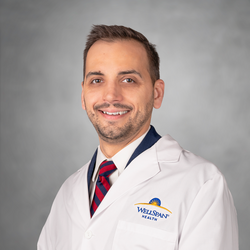

Roughly 1 in 3 people in the U.S. will experience chronic pain. They spend $635 billion each year trying to get better, making it the most expensive health condition in the nation.

Christopher Echterling, MD
Finally, we know what it takes to solve this towering problem: a comprehensive program combining clinical care, body work and behavioral therapy — united under a revolutionary understanding of how chronic pain works.
In 2023, WellSpan Health became the first health system in the U.S. offering this kind of program as a standard health care service covered by select Medicare, Medicaid and commercial insurance plans. Since then, almost 300 patients have enrolled, with outstanding results.
“Patients are graduating with an entirely new relationship to pain and a new outlook on their lives,” says Christopher Echterling, MD, a family practice physician who serves as medical director of vulnerable populations at WellSpan Health.
The brain processes chronic pain differently
Chronic pain is pain that lasts more than three months — but what really distinguishes it is where it lives in the brain.
Acute pain is processed in the anterior cingulate cortex and other areas. Chronic pain migrates to the main prefrontal cortex and amygdala: areas associated with learning, emotion and making sense of the world.

Sergey Borodianski, MD
“Chronic pain is learned pain. It’s as real as the pain you feel when you’re injured. But the brain has memorized its response to the injury, and it repeats that response long after the injury has healed,” says Sergey Borodianski, MD, a physical medicine rehabilitation specialist and lead physician in the program.
A revolutionary approach
To meet the unique needs of chronic pain patients, the WellSpan Restorative Pain Program addresses mind and body together.
Helping patients reprocess pain
The overarching treatment philosophy is called Pain Reprocessing Therapy (PRT) — an evidence-based approach that trains the brain to reinterpret the signals it’s misreading.
“PRT helps you ‘unlearn’ chronic pain,” says Dr. Borodianski.
And research shows it works. The seminal study for PRT, published in 2021, found that 66% of patients with chronic back pain were pain-free or nearly pain-free following treatment with PRT, compared with 20% in the placebo group and 10% who received standard care.
Dr. Borodianski and Lisa Ryan — a clinical social worker specializing in behavioral health — lead patients through PRT throughout a 12-month period.
“It takes time to rewire your brain,” says Dr. Borodianski.
Providing a range of treatment modalities
Alongside PRT, the program provides a personalized care plan that can include:
- Acupuncture
- Behavioral Health
- Massage Therapy
- Meditation
- Nutrition
- Pain interventions and medications
- Physical Medicine
- Physical Therapy
- Reiki
- Yoga
Patients may see as many as five specialists in a single visit — and the team often rethinks their plan in real-time, based on how a patient presents.
For example, a patient may tell the intake nurse they had a bad fight with their spouse. Based on this, the massage therapist might request to see the patient first, so they are more relaxed going into physical therapy. The nurse coordinator reshuffles the plan — and the patient gets exactly what they need, when they need it, to get the most out of their visit.
The difference they’ve been waiting for
Outcome data from the program’s first cohort of patients show that they are far less consumed by their pain and more hopeful about their futures.

One patient, in her 20s, had lived for two years with complex regional pain syndrome in her feet. Treatment focused on gradually increasing milestones: walking to the mailbox and back, then walking around the block, and so on. By her eighth month in the program, she had resumed her old job.
“She even twisted her ankle at one point but avoided a relapse into despair and immobility,” says Dr. Borodianski.
Helping as many people as we can
The WellSpan Health team will soon publish its data on outcomes and cost-of-care savings to get more payers to cover the program.
|
Currently, eligible patients include adults with chronic pain who:
|
If a patient isn’t eligible, Dr. Echterling says that providers can educate them about the mind-body relationship and range of modalities that may help.
“Most of all, assure them their pain is real. And it isn’t inevitable. There is a way out.”
Call 717-356-4705 or fax 717-207-8919 to refer a patient to the WellSpan Restorative Pain Program.
